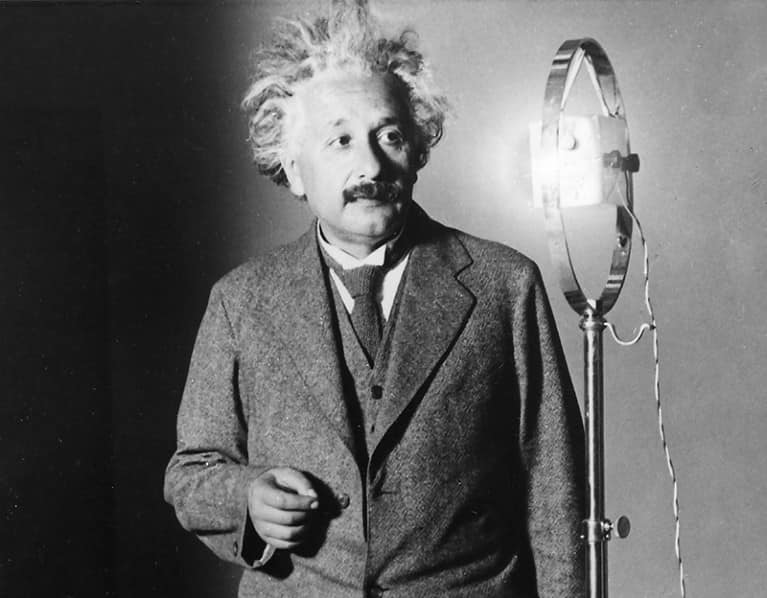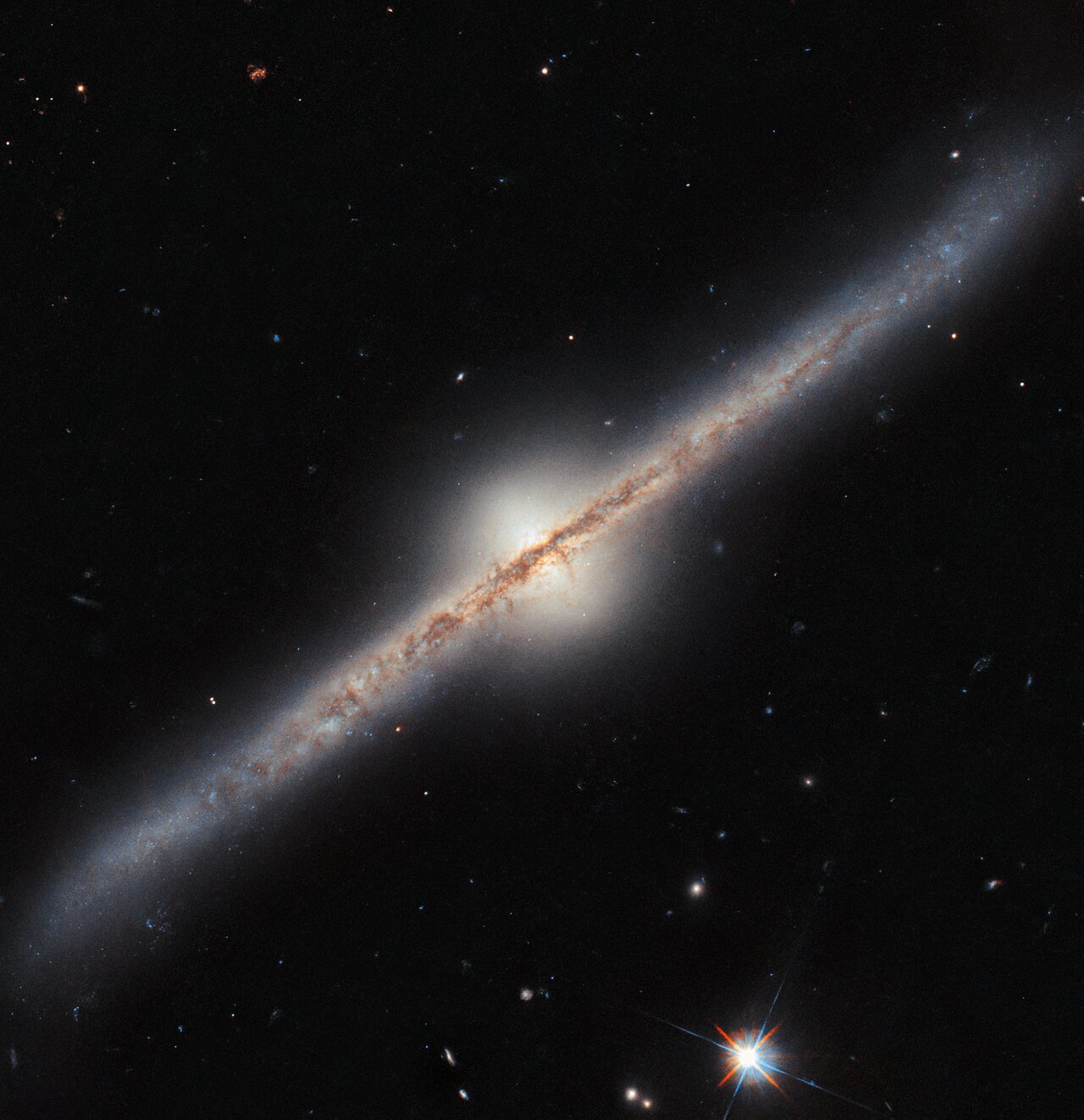Blog
While it may seem that these long and thin clouds are pointing toward the top of a hill, and that maybe a world-famous observatory is located there, only part of that is true. In terms of clouds, the formation is a chance superposition of impressively periodic undulating air currents in Earth’s lower atmosphere. Undulatus, a type of Asperitas cloud, form at the peaks where the air is cool enough to cause the condensation of opaque water droplets. The wide-angle nature of the panorama creates the illusion that the clouds converge over the hill. In terms of land, there really is a world-famous observatory at the top of that peak: the Carnegie Science‘s Las Campanas Observatory in the Atacama Desert of Chile. The two telescope domes visible are the 6.5-meter Magellan Telescopes. The featured coincidental vista was a surprise but was captured by the phone of a quick-thinking photographer in late September.

Malcolm John Rebennack, Jr. (November 20, 1941 – June 6, 2019), better known by his stage name Dr. John, was an American singer, songwriter and pianist. His music combined New Orleans blues, jazz, R&B, soul and funk.
Active as a session musician from the late 1950s until his death, he gained a following in the late 1960s after the release of his album Gris-Gris (1968) and his appearance at the Bath Festival of Blues and Progressive Music (1970). He typically performed a lively, theatrical stage show inspired by medicine shows, Mardi Gras costumes, and voodoo ceremonies. Rebennack recorded thirty studio albums and nine live albums, as well as contributing to thousands of other musicians’ recordings. In 1973, he achieved a top-10 hit single with “Right Place, Wrong Time“.
more...Clifton “Skeeter” Best (November 20, 1914 – May 27, 1985) was an American jazzguitarist.
Best played in Philadelphia from 1935 to 1940, recording with Slim Marshall and Erskine Hawkins. In 1940, he joined Earl Hines‘s orchestra, playing with him until he joined the U.S. Navy in 1942. After the war, he played with Bill Johnson from 1945 to 1949. He toured East Asia with Oscar Pettiford in 1951 and 1952, and formed his own trio in the 1950s. He did a critically acclaimed session with Ray Charles and Milt Jackson in 1957 called Soul Brothers.
In 1958, he recorded with Mercer Ellington and taught in New York City. He also recorded with Harry Belafonte, Etta Jones, Nellie Lutcher, Milt Hinton, Osie Johnson, Paul Quinichette, Jimmy Rushing, Sonny Stitt, Charles Thompson, and Lucky Thompson.
more...Howard Duane Allman (November 20, 1946 – October 29, 1971 Nashville, TN) was an American rock and blues guitarist and the founder and original leader of the Allman Brothers Band, for which he was posthumously inducted into the Rock and Roll Hall of Fame in 1995.
Born in Nashville, Tennessee, Allman began playing the guitar at age 14. He formed the Allman Brothers Band with his brother Gregg in Jacksonville, Florida, in 1969.The group achieved its greatest success in the early 1970s. Allman is best remembered for his brief but influential tenure in the band and in particular for his expressive slide guitar playing and inventive improvisational skills. A sought-after session musician both before and during his tenure with the band, Duane Allman performed with such established stars as King Curtis, Aretha Franklin, Herbie Mann, Wilson Pickett, and Boz Scaggs. He also contributed greatly to the only studio album by Derek and the Dominos, Layla and Other Assorted Love Songs (1970).
Allman died following a motorcycle crash on October 29, 1971, at the age of 24.
In 2003, he was ranked number 2 in Rolling Stone magazine’s list of the 100 greatest guitarists of all time, second only to Jimi Hendrix. In 2011, he was ranked number 9 and in 2023 he was ranked 10th. His guitar tone (achieved with a Gibson Les Pauland two 50-watt bass Marshall amplifiers) was named one of the greatest of all time by Guitar Player.
more...Meredith Jane Monk (born November 20, 1942 NY,NY) is an American composer, performer, director, vocalist, filmmaker, and choreographer. From the 1960s onwards, Monk has created multi-disciplinary works which combine music, theatre, and dance, recording extensively for ECM Records.[1] In 1991, Monk composed Atlas, an opera, commissioned and produced by the Houston Opera and the American Music Theater Festival. Her music has been used in films by the Coen Brothers (The Big Lebowski, 1998) and Jean-Luc Godard (Nouvelle Vague, 1990 and Notre musique, 2004). Trip hopmusician DJ Shadow sampled Monk’s “Dolmen Music” on the song “Midnight in a Perfect World“. In 2015, she was awarded the National Medal of Arts by Barack Obama.
more...
Stars can create huge and intricate dust sculptures from the dense and dark molecular clouds from which they are born. The tools the stars use to carve their detailed works are high energy light and fast stellar winds. The heat they generate evaporates the dark molecular dust as well as causing ambient hydrogen gas to disperse and glow. Pictured here, a new open cluster of stars designated IC 1590 is nearing completion around the intricate interstellar dust structures in the emission nebula NGC 281, dubbed the Pac-man Nebula because of its overall shape. The dust cloud just above center is classified as a Bok Globule as it may gravitationally collapse and form a star — or stars. The Pacman Nebula lies about 10,000 light years away toward the constellation of Cassiopeia.

more...
Just as Billy Elliot discovered his love of dance on the way to his boxing lesson, José Molina Quijada, born in Madrid on November 19, 1936, was enrolled in a boxing school which shared space with Spanish dancers. In 1945, the nine year old Molina saw Pilar López and José Greco perform and knew that dance was his future.
His father, Ramón Molina, a Republican who was imprisoned for three years during the Spanish Civil War and then worked in a fish market, was adamantly opposed, but his mother, Carmen Quijada, accepted his ambition on the condition that he pay for his classes by working mornings in the fish market. For six years José earned just enough to pay for classes with Pilar Monterde in neo-Classical Spanish dance, Escuela Bolera, Ballet and Flamenco. Soledad Miralles, dancing in Madrid at the Lope de Vega Theatre, gave Molina his first break. From age sixteen to nineteen, he toured nightclubs throughout Europe and the Middle East as a Flamenco and Classical Spanish dance soloist accompanied by piano and orchestra.
In 1956, he came to New York to audition, successfully, for The Tonight Show, to which he returned as a regular guest and performer, as well as appearances on the Ed Sullivan and Merv Griffin television shows. José Greco presented him as a soloist in his internationally touring company for five years before he formed his own company, José Molina Bailes Españoles, in 1961. Molina’s only sibling Ramón played guitar in his company in the early years.
For more than 30 years his company toured North America annually, performing in 49 states and over 400 cities, including engagements at NYC’s Carnegie Hall and with the Boston Pops. His fame led to featured roles in a commercial for Levi Jeans and a music video for Carly Simon.
Molina’s charisma on stage transferred to the classroom where he drew countless students in NYC as well as in residencies across the US, including Miami, FL and Portland, OR. His classes included many he groomed to be professional dancers as well as others for whom flamenco was simply a personal passion. He welcomed everyone, demanding discipline and technical precision while teaching with a unique warmth, charm, and sense of humor.
In 2012 he became a US citizen and maintained dual citizenship.
more...Henry “Hank” Medress (November 19, 1938 – June 18, 2007) was an American singer and record producer, best known for his taking part in the American band The Tokens.
Medress was born in Brooklyn, New York City, where he attended “Abraham Lincoln” High School. In 1955 he joined a doo-wop group called the Linc-Tones, from the surname of that President of the United States, which also included at first Neil Sedaka. After Sedaka’s departure, the group reformed with additional singers as The Tokens in 1958, after several changes of name. The Tokens achieved a #1 chart success in 1961 with their arrangement of “The Lion Sleeps Tonight“, a remake of the 1939 song “Mbube” by South African singer Solomon Linda. Medress and the Tokens also produced hits for The Chiffons, such as “He’s So Fine“.
more...Ofra Haza (Hebrew: עפרה חזה; 19 November 1957 – 23 February 2000) was an Israeli singer, songwriter, and actress, commonly known in the Western world as “the Madonna of the East“, or “the Israeli Madonna”. Her voice has been described as a “tender” mezzo-soprano. In 2023, Rolling Stone ranked Haza at number 186 on its list of the 200 Greatest Singers of All Time.
Of Yemenite-Mizrahi descent, Haza performed music known as a mixture of traditional Middle Eastern and commercial singing styles, fusing elements of Eastern and Western instrumentation, orchestration and dance-beat, as well as lyrics from Mizrahi and Jewishfolk tales and poetry. By the late 1980s, Haza was an internationally successful artist, achieving large success in Europe and the Americas and appearing regularly on MTV.During her singing career, she earned many platinum and gold discs and her music proved highly popular in the club scene. By the 1990s, at the peak of her career,she was regularly featured in movie soundtracks, such as that of Dick Tracy (1990) and famously in The Prince of Egypt (1998), and her vocals were popularly sampled in hip hop. Her death in 2000 from an AIDS-related illness shocked Israeli society.
Haza was a highly influential cultural figure in Israel, and is considered one of the country’s biggest cultural icons, who helped popularize Mizrahi culture.
more...Kenny Werner (born November 19, 1951) is an American jazz pianist, composer, and author.
Werner started his own trio in 1981 with drummer Tom Rainey and bassist Ratzo Harris. The Kenny Werner Trio matured for fourteen years, touring in America and Europe and recording four albums along the way.
In the 1980s, he became the pianist for The Thad Jones/Mel Lewis Orchestra (now known as the Vanguard Jazz Orchestra). Challenged by Lewis and Bob Brookmeyer to write for the band, he produced his first compositions and arrangements for jazz orchestra, consequently leading him to write for the bands in Europe including the Cologne, Danish, and Stockholm Jazz Orchestras, the Umo Jazz Orchestra of Finland and several times as the guest composer and soloist with the Metropole Orchestra of Holland. Since then Werner has had commissions to write for large ensembles such as jazz orchestras, full orchestras and most in 2007, wind ensemble, choir and string quartet as featured on his album No Beginning, No End (2009).
more...Today Tuesday November 19th 2024 marks 1,000 Days of War in Ukraine with Russia & Putin
more...What kind of astronomical object is this? It doesn’t look quite like the kinds of galaxies, nebulae, star clusters or galaxy clusters which Hubble normally brings us images of. In fact, this is a spiral galaxy, named UGC 10043 — we just happen to be seeing it directly from the side! Located roughly 150 million light-years from Earth in the constellation Serpens, UGC 10043 is one of the somewhat rare spiral galaxies that are seen edge-on.
From this point of view, we see the galaxy’s disc as a sharp line through space, overlain with a prominent dust lane. This dust is spread across the spiral arms of UGC 10043, but it looks very thick and cloudy when viewed from the side. You can even see the lights of some active star-forming regions in the arms, shining out from behind the dust. Strikingly, we can also see that the centre of the galaxy sports a glowing, almost egg-shaped ‘bulge’, rising far above and below the disc. All spiral galaxies have a bulge like this one as part of their structure, containing stars that orbit the galactic centre on paths above and below the whirling disc; it’s a feature that isn’t normally obvious in pictures of galaxies. The unusually large size of this bulge compared to the galaxy’s disc is possibly thanks to UGC 10043 siphoning material from a nearby dwarf galaxy. This may also be why the disc is warped, bending up at one end and down at the other.
Like most of the full-colour Hubble images released by ESA/Hubble, this image is a composite, made up of several individual snapshots taken by Hubble at different times and capturing different wavelengths of light. You can see the exact images used in the sidebar on this page. A notable aspect of this image is that the two sets of Hubble data used were collected 23 years apart, in 2000 and 2023! Hubble’s longevity doesn’t just afford us the ability to produce new and better images of old targets; it also provides a long-term archive of data which only becomes more and more useful to astronomers.
[Image Description: A spiral galaxy seen directly from the side, such that its disc looks like a narrow diagonal band across the image. A band of dark dust covers the disc in the centre most of the way out to the ends, and the disc glows around that. In the centre a whitish circle of light bulges out above and below the disc. The tips of the disc are a bit bent. The background is black and mostly empty.]

Ignacy Jan Paderewski (Polish. 18 November [O.S. 6 November] 1860 – 29 June 1941) was a Polish pianist, composer and statesman who was a spokesman for Polish independence. In 1919, he was the nation’s prime ministerand foreign minister during which he signed the Treaty of Versailles, which ended World War I.
A favorite of concert audiences around the world, his musical fame opened access to diplomacy and the media, as possibly did his status as a freemason, and charitable work of his second wife, Helena Paderewska. During World War I, Paderewski advocated an independent Poland, including by touring the United States, where he met with President Woodrow Wilson, who came to support the creation of an independent Poland in his Fourteen Points at the Paris Peace Conference in 1919, which led to the Treaty of Versailles.
Shortly after his resignation from office, Paderewski resumed his concert career to recoup his finances and rarely visited the politically chaotic Poland thereafter, the last time being in 1924.
more...
Cindy Blackman Santana (born November 18, 1959), sometimes known as Cindy Blackman, is an American jazz and rock drummer. Blackman has recorded several jazz albums as a bandleader and has performed with Pharoah Sanders, Sonny Simmons, Ron Carter, Sam Rivers, Cassandra Wilson, Angela Bofill, Buckethead, Bill Laswell, Lenny Kravitz, Joe Henderson and Joss Stone.
Blackman was born November 18, 1959, in Yellow Springs, Ohio. Her mother and grandmother were classical musicians and her uncle was a vibist. As a child, her mother took her to classical concerts.
Blackman’s introduction to the drums happened at the age of seven in Yellow Springs. At a pool party at a friend’s house. she saw a drum set and began playing them. “Just looking at them struck something in my core, and it was completely right from the second I saw them,” says Blackman. “And then, when I hit them, it was like, wow, that’s me.” Soon after, Blackman began playing in the school band and persuaded her parents to get her toy drums.
When Blackman was 11, she moved to Bristol, Connecticut, where she attended the Hartt School of Music in Hartford.Blackman began to have an interest in jazz at age 13 after listening to Max Roach and got her first professional drum set at 14.
Blackman then attended the Berklee College of Music in Boston, where she studied with Alan Dawson, who had also taught Tony Williams, an inspiration for Blackman. While she was at Berklee, a friend recommended her for a gig with The Drifters, so Blackman left college after three semesters and moved to New York City in 1982.
more...More Posts
- Naughty or Nice
- Cosmos NGC 7727
- Christopher Parkening
- Phineas Newborn Jr.
- Cecil Payne
- Clark Terry
- World Music Sauljaljui
- Daily Roots Roots Radics
- John Trudell Being Human
- Friday the 13th 2024
- Cosmos M51
- Joe Messina
- Ben Tucker
- Sonny Greer
- Daily Roots Scientist
- Flamenco Fridays Carlos Montoya
- Graffiti Human Suffering
- Dr Who Facts
- Cosmos M45
- Alex Acuña

